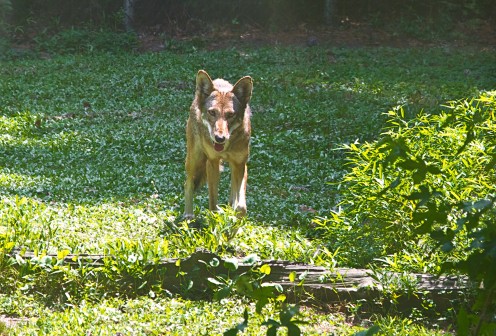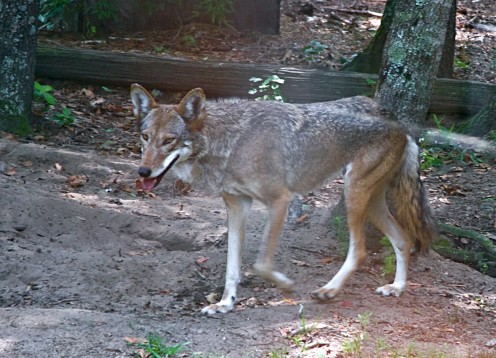Red Wolves: Are They Worth Saving From Extinction?

Red Wolves are endangered with less than 100 animals in the wild and another 200 red wolves exist worldwide, mostly in zoos or at federal captive breeding sites, such as the one at Cape Romain’s Sewee Visitor’s Center. Government programs are costly with no end in site. Should we be doing all we can to save them from extinction?
Hey, where are orchids? I don't know, but we have red wolves!
I recently had the privilege of photographing a captive red wolf at the Sewee Visitor and Environmental Education Center in South Carolina quite by accident. On a whim a decision was made to visit the center so I could find out where the orchids were in the Francis Marion National Forest. I had read there was 32 species of orchids somewhere in the forest and I wanted to photograph some of them. While the folks at the visitors center could not answer my question about the orchids, they said they had a red wolf exhibit on site that was worth viewing. Now, I had never even heard of a red wolf up to that point and was very curious about them. Were they really red? The exhibit was behind glass and when I first came upon it, I saw an animal that, to me, seemed stressed to be in an area so small. She appeared to be pacing and my heart went out to her. I said out loud, but to myself, why is she captive? Why don't they let her be free? To my surprise, wolf keeper, Rob Johnson was standing nearby and heard my comments. He assured me that the female was not pacing nervously, but was excited because it was close to feeding time, explaining in great detail his techniques for keeping his wolves engaged and active in their caged environment. Then he began to tell me the sad tale of the red wolf. While I listened, I photographed the female, but I was restricted by the glass, and only managed to get a few good photographs.

The Plight Of The Red Wolf
These very shy animals are grayish with rust-colored hues that can weigh up to 80 pounds and stand 26 inches at the shoulder. They are smaller than western gray wolves, which can weigh as much as 120 pounds, but larger than coyotes and are considered not dangerous because of their timid nature. In fact, they are flat out afraid of humans and will even defecate themselves when forced into interaction. Before man interfered, the red wolf used to roam the southeastern forests and bayous of the united states from New England all the way to Texas and had a place to call home. Mating for life, the red wolves raised their pups in peace on huge expanses of land in which they hunted and lived. Enter the white man, and by the early 1900's red wolves disappeared from much of the South thanks to a bounty paid by the government for intensive predator control programs along with the decimation and alteration of their habitat. Recklessness and unreasonable fear of these reclusive animals, almost annihilated them from the face of the earth. Most people had never even heard of red wolves until they were almost gone. By 1967, they were considered endangered in the wild and what was left were rounded up to begin breeding programs.
Fish And Wildlife Service To The Rescue
The red wolf reintroduction was the first wolf reintroduction in the United Sates. Mysteriously, most are unaware of that fact. They, like me, had only heard of the gray wolf program in Yellowstone and assumed that it was the first of it's kind. However, In 1987, the government, specifically the United States Fish and Wildlife Service (FWS) began an effort to replenish the South with red wolves with the recovery program in the Alligator River National Wildlife Refuge in northeastern North Carolina. Originally, 144,000 acres of land were allotted for the reintroduction program. Today, the red wolves roam on about 1.7 million acres on and around the refuge. To seed the refuge, captive breeding pairs were released on barrier islands in South Carolina, Florida and Mississippi and when the pups reached an appropriate age, they were skillfully added to natal litters of breeding pairs in the Alligator River Refuge. Due to the strong maternal instincts of a red wolf female, the new pups were adopted seamlessly by the red wolves into their new family. The report of wild red wolves today varies according to my research from 20 to 100. However, the Alligator River program is considered a success even though the struggling red wolf population have been shot by hunters who say they mistook them for coyotes. Statistics prove that most of the wolves killed were adults and are much larger than coyotes and extremely difficult to mistake for coyotes. Recent studies have revealed that of the 312 red wolves that were killed between 1987 and 2010, a whopping 52% were directly related to human interference. Of the 52%, 26% were labeled foul play. It seems the rare and evasive red wolf is still hated, targeted and misunderstood by ignorance, folklore and myths. Fish and Wildlife Service have very little clout when dealing with these poachers, because hunting coyotes is legal in North Carolina and all they have to say is that is was a case of mistaken identity. Unfortunately, these killings have escalated in recent years resulting in fewer breeding pairs, which could jeopardize the reintroduction completely.
Wolf keeper, Rob Johnson was rather proud of his efforts at the Seewee center and feels that the only way to keep the wolves from going extinct, is to keep them in captivity. Sadly, he really did not see much a future for the persecuted species. Rob was successful in breeding a pair of red wolves at the facility in Seewee and was as proud as a parent as he showed me pictures of the family. He even considered his efforts and successful outcome to be his life goal.
I don't know how you feel, but 100 of any wild specie is not a success to me. It seems the poor red wolf will only remain on the earth in captivity. This saddens me. Nothing wild should be in captivity, no matter how spacious the cage may seem.

Disappearance Of Habitat And Sterilization
If being killed by ignorance wasn't enough, there is another problem that is a threat to the extinction of the red wolves. It seems that there is a cross-breeding with coyotes that can occur producing a type of coyote-wolf hybrid which will eventually wipe out the red wolf population. Typically these hybridization events occur after a stable breeding pair has been split apart for one reason or another. Wolf man, Rob Johnson felt that the red wolf males were far more likely to cross breed than females. Contributing to the cross breading issue is the disappearance of habitat for both coyotes and red wolves is forcing them to intermingle more than they should. Historically, red wolves, being the larger, more dominant specie, should force the coyotes out but an unbalance of natural behaviors has occurred due to the low population of red wolves.
In the Alligator River Refuge, management of cross breeding is conducted by sterilization of the coyotes and euthanasia of any hybrid pups born to the red wolves managed by the FWS. In my opinion, this is a radical approach, but the Fish and Wildlife's main objective is re--population of the red wolves and they will stop at nothing to further the program. Is this what it will take to ensure the red wolves and thriving in the wild once again? Some think so. It is it is a never ending task for sure until the red wolf populations are back to normal, if that is even possible. It could be a perilous interference, trading one species for the other, and remember, it was the interference of man that caused the problem in the first place. It is clear to me that human interference with the natural order of things is never a good idea. Does this strategy really "fix" the problem? Why not just start killing all the coyotes in the red wolf territories? Seems like one approach is as good as another here.
For sure the issue is complicated. T. DeLene Beeland, in her book The Secret World of Red Wolves, tells the story in detail from all points of view and would be well worth the read if you find this subject is raising the hackles on the back of your neck. Can we indeed save this magnificent species from extinction? The numbers of from 20-100 in the wild are heart breaking. It may be the only way to "save" them is to put them in zoos. That is equally heartbreaking. But, can the resources be justified? Some would say not. That there are starving humans that should take precedence, as if humans are any more important than any other living thing on this planet. If we were the cause of their annihilation in the first pace, we humans, should do whatever it takes to put things to rights. The wolves were here for a reason. They are part of a delicate environmental balance
As Rare And Precious As An Orchid
Wolfman Rob Johnson said, now that they had the success of breeding the red wolf in captivity, it was likely the program at the Seewee center will come to an end. I asked what will happen to the wolves if that were to occur. He said they would most likely be sent to another captive program, released into a refuge or even be euthanized. I just shook my head. I know the effort by the government seems gallant and even heroic, but hearing the options left to these wolves, who were obviously Johnson's "babies", just made me heart sick.
I am grateful that I was allowed to photograph this rare beauty. Not an orchid, but every bit as beautiful and precious. The orchids will have to wait for next time.








